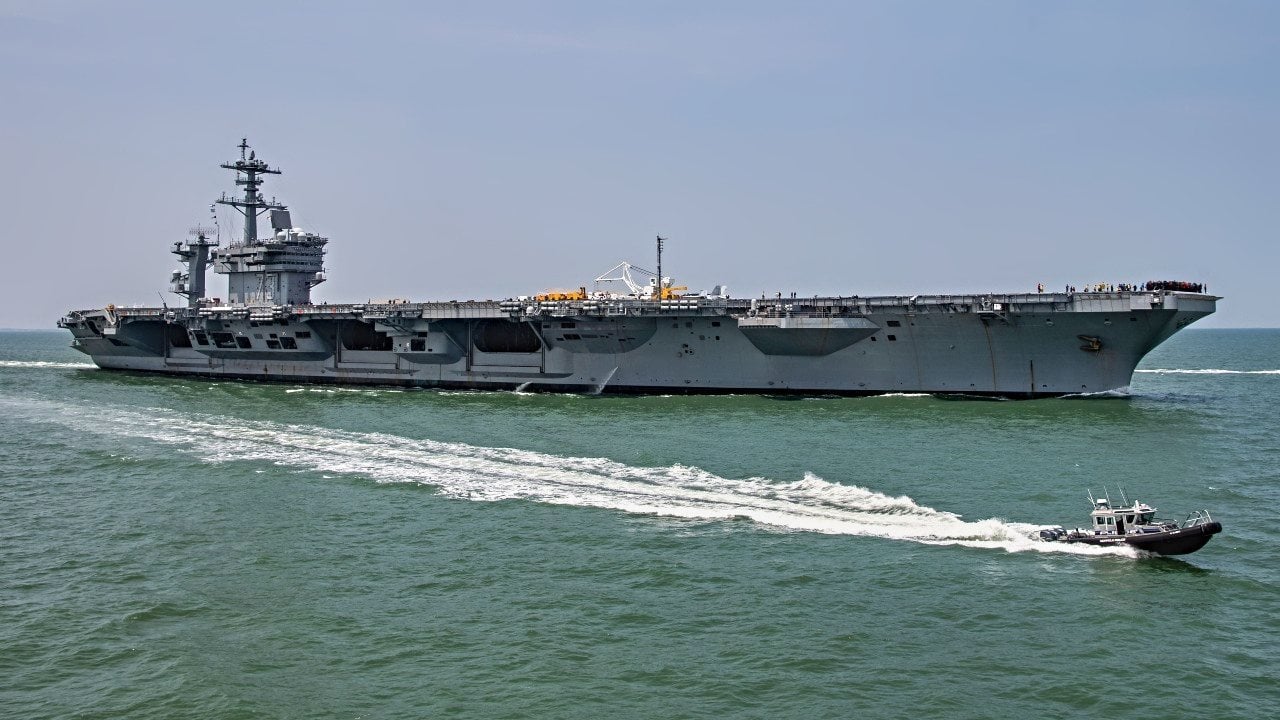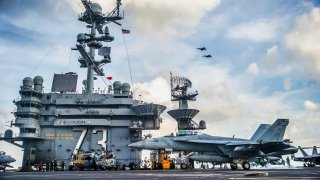'Out of Action' 2,117 Days: Why Aircraft Carrier USS George Washington Couldn't Sail
USS George Washington (CVN-73), the U.S. Navy's sixth Nimitz-class aircraft carrier, recently completed a grueling six-year, $2.8 billion Refueling and Complex Overhaul (RCOH), significantly longer than initially planned due to COVID-19, supply chain issues, and unexpected repairs.
Aircraft Carrier Problems for the U.S. Navy: USS George Washington (CVN-73), the U.S. Navy's sixth Nimitz-class aircraft carrier, recently completed a grueling six-year, $2.8 billion Refueling and Complex Overhaul (RCOH), significantly longer than initially planned due to COVID-19, supply chain issues, and unexpected repairs.
-The overhaul took a heavy toll on the crew, with nine sailors tragically dying by suicide during the process.
Bottomline: As the carrier takes over forward deployment from USS Ronald Reagan, the Navy is implementing improvements to avoid similar issues in future RCOHs, such as that of USS John C. Stennis (CVN-74).
USS George Washington’s Grueling 6-Year Overhaul: Lessons Learned and Tragedies Endured
Founding father George Washington was no stranger to ordeal and hardship – enduring the harsh winter of 1777-1778 at Valley Forge, while he faced numerous setbacks on the battlefield. It is with sad irony that the current warship named in his honor has also undergone its own trials and tribulations.
The United States Navy's sixth Nimitz-class nuclear-powered supercarrier, USS George Washington (CVN-73), recently went to San Diego and is completed a "hull swap" operation with sister vessel USS Ronald Reagan (CVN-76). CVN-73 will take over the forward-deployment role from CVN-76 and will be based at Yokosuka, Japan, for the better part of the next decade.
For the sailors serving on USS George Washington, it is certainly good to be back at sea following the ordeal that was its Refueling and Complex Overhaul (RCOH). Such work occurs at the warship's mid-life and involves the replacement of expended nuclear fuel – as well as the modernization of the vessel.
The Epic RCOH for Aircraft Carrier USS George Washington
CVN-73 completed its $2.8 billion RCOH upgrade at HII's Newport News Shipbuilding (NNS), in Norfolk, Virginia in May 2023. In total, the flattop's maintenance period lasted 2,117 days – nearly six years, and about two years longer than expected for an RCOH.
"Refueling complex overhauls are performed at the mid-point of a ship's 50-plus-year lifespan, incorporating upgrades to propulsion equipment, infrastructure, and combat support systems," the U.S. Navy explained.
The delays involving CVN-73 were largely due to the COVID-19 pandemic and national lockdown, which stopped work entirely for a period, followed by supply chain issues, and competing requirements for resources. The United States Navy currently lacks the facilities and the workers to properly maintain its fleet.
There have also been reports that some work was done incorrectly, resulting in unexpected repairs, which dragged out the RCOH for USS George Washington.

"Factors that extended the RCOH included delays and changes in her RCOH planning and induction timeline due to FY15 budgetary decisions to inactivate (vice refuel) this ship; the arrival condition of the ship, which was more challenging than expected, planned or budgeted for, including growth work in significant areas of the RCOH; the requirement to remove critical parts from CVN-73 to support higher-priority, deploying aircraft carriers; and the impact of COVID-19 on the workforce and industrial base," HII said in a May 2023 statement to USNI News.
It took a heavy toll on the crew.
Even as the aircraft carrier was essentially a worksite for much of the nearly six years, sailors largely continued to live on the vessel. Nine sailors assigned to the carrier died by suicide, which prompted a quality of life investigation.
Improving the Next RCOH
The U.S. Navy found that the sailors faced poor living conditions and limited access to mental healthcare. As a result, the sea service has looked to address the issue with subsequent Nimitz class RCOHs. That will include expanding the rotating pool of parts as well as addressing the long lead time for materials. New technologies, notably 3D scanning, are being implemented to streamline various processes, including inspections as the work is completed.
However, the U.S. Navy may already be facing a bit of déjà vu, as damage to steam turbines has been found on USS John C. Stennis (CVN-74), which is now undergoing her RCOH. Similar problems with CVN-73 contributed to her delays as it added unplanned work.
The RCOH for CVN-74 is currently scheduled to last five and a half years, so it is hoped the U.S. Navy is better equipped to ensure that its sailors don't go through such an ordeal as they did with CVN-73.
Author Experience and Expertise: Peter Suciu
Peter Suciu is a Michigan-based writer. He has contributed to more than four dozen magazines, newspapers, and websites with over 3,200 published pieces over a twenty-year career in journalism. He regularly writes about military hardware, firearms history, cybersecurity, politics, and international affairs. Peter is also a Contributing Writer for Forbes and Clearance Jobs. You can follow him on Twitter: @PeterSuciu. You can email the author: [email protected].
All images are Creative Commons.


